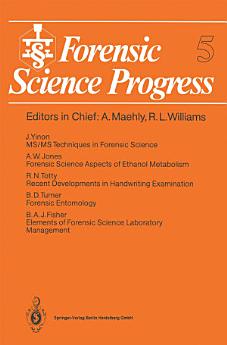Forensic Science Progress: Volume 5
ธ.ค. 2012 · Forensic Science Progress หนังสือเล่มที่ 5 · Springer Science & Business Media
eBook
182
หน้า
reportคะแนนและรีวิวไม่ได้รับการตรวจสอบยืนยัน ดูข้อมูลเพิ่มเติม
เกี่ยวกับ eBook เล่มนี้
One of the surprising things about the natural world is that animals are dying around us all the time and yet we rarely see any evidence of it. This is a testimony to the efficiency of the large variety of organisms which decompose animal corpses. Whilst bacteria and fungi are the main groups involved in decomposition processes, the larger insects additionally provide an important physical disruption of body tissues, which aids the penetration of micro organisms and speeds the collapse of the body structure. A human corpse is treated no differently and the same groups of organisms are involved. From a forensic science viewpoint the universality of the decay process provides two major advantages. Information based on the decomposition of animals is of considerable value when considering human cases and the successional pattern of decay is broadly equivalent wherever the process is being studied. Historically, the usefulness of insects in solving crime can be traced back in the literature to the 13th century. McKnight [1, 2] translated a Chinese text of this period which contains an account of how a law officer dealt with a case of murder in the rice fields. Death had been caused by a sickle and the official ordered all the field workers to line up and lay their sickles on the ground in front of them. Flies began to be attracted to one of the sickles whereupon its owner confessed to the crime.
ให้คะแนน eBook นี้
แสดงความเห็นของคุณให้เรารับรู้
ข้อมูลในการอ่าน
สมาร์ทโฟนและแท็บเล็ต
ติดตั้งแอป Google Play Books สำหรับ Android และ iPad/iPhone แอปจะซิงค์โดยอัตโนมัติกับบัญชีของคุณ และช่วยให้คุณอ่านแบบออนไลน์หรือออฟไลน์ได้ทุกที่
แล็ปท็อปและคอมพิวเตอร์
คุณฟังหนังสือเสียงที่ซื้อจาก Google Play โดยใช้เว็บเบราว์เซอร์ในคอมพิวเตอร์ได้
eReader และอุปกรณ์อื่นๆ
หากต้องการอ่านบนอุปกรณ์ e-ink เช่น Kobo eReader คุณจะต้องดาวน์โหลดและโอนไฟล์ไปยังอุปกรณ์ของคุณ โปรดทำตามวิธีการอย่างละเอียดในศูนย์ช่วยเหลือเพื่อโอนไฟล์ไปยัง eReader ที่รองรับ







